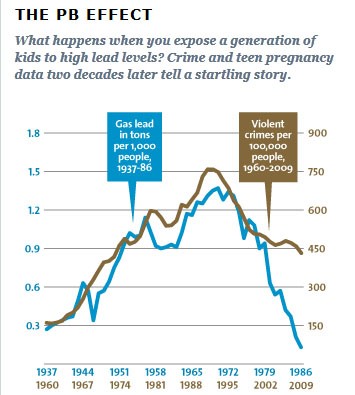
Writing at Mother Jones, Kevin Drum argues that environmental lead is largely responsible for the increase, and subsequent drop, in crime the United States experienced since the 1960s.
Crime reached a mid-century low in the United States around 1958. From that point crime, including violent crime, rose at a fairly steady pace until the early 90s. But then something unexpected happened. Crime began to decrease steadily every year, eventually bringing the US murder rate down to levels not seen since the early 1960s.
Many explanations have been offered for the increase in the nations’ crime–drugs, demographics, poverty. Each seemed to show some correlation with the increase but struggled to explain the long steady drop that followed.
On the other side of the equation, there were plenty of law enforcement efforts which may have helped reduce crime: mandatory sentencing, community-oriented policing, greater investments in incarceration. But here again the correlation is not perfect and it is arguable that these changes may only account for a fraction of the overall decrease.
Kevin Drum, relying on the work of Rick Nevin, argues for an alternative explanation which might help explain both the increase and decrease in crime. It turns out that the concentration of atmospheric lead rose and then dropped in a way that mirrors the rise and drop in crime rates. This is the result of gasoline additives which were once common but later dropped in favor of unleaded gasoline.
If you allow for a shift of 23 years from the time infants and young children would be exposed to dangerous levels of lead and the point where young adult males typically become most violent you see a strong correlation.

What’s more interesting is that the correlation seems to hold up anywhere you look. A study comparing lead levels in six US cities and crime levels 22 years later found the same results. An examination by Nevin of lead levels and crime in other nations around the world found the same matching graphs (again with a time shift of two decades):

Drum’s article goes on to consider what we know about the medical effects of lead exposure on individuals. The research he offers includes studies which show changes in the brain, including loss of grey matter in the prefrontal cortex, that fit well with the idea of loss-of-control and violence. In other words, there does seem to be a plausible mechanism for the toxin, lead, creating the problem, violent crime.
The final portion of Drum’s article is concerned with how to alleviate lead, most of which remains in our soil. He advocates for a significant amount of spending on lead abatement measures, $20 billion a year for 20 years, claiming that the payoff in reduced crime and increased opportunity will more than offset the cost.
So far, only a few individuals on the right have offered any response to Drum’s argument. Ronald Bailey at Reason seems less than impressed. He notes that ADHD diagnosis (which Drum also connects to environmental lead) is up despite the drop in lead levels.
Bailey is correct about the increase in ADHD diagnoses, but even the source he links to suggests this is “likely due to an increased awareness of ADHD, which may have caused morephysicians to recognize symptoms and diagnose the disorder.” In other words, what’s up is awareness among doctors (and presumably among parents as well) leading to more diagnoses. It’s not clear that the actual number of people with ADHD has risen at anything close to this rate over a decade.
Bailey seems on stronger ground arguing that a similar increase in crime which peaked in the 1930s seems to precede the spread of atmospheric via automobiles by several decades. Obviously if lead is such an overwhelming factor in crime rates (driving them both up and down in the last 60 years) it would also have to be a significant factor prior to 1950. Perhaps it is, but Drum doesn’t address or attempt to explain any changes in US crime rates prior to 1960.
Finally, blogger Tom Maguire notes that whether or not the thesis Drum is promoting is ultimately correct, the history of lead additives in fuel is not one of our proudest moments as a nation. This summary he links reads like an Occupy bedtime story.

COMMENTS
Please let us know if you're having issues with commenting.